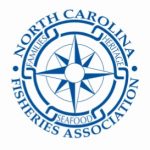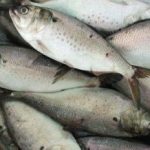Tag Archives: Lake Michigan
Wild Things: State of the Commercial Fishery
 At its monthly meeting in Madison Wednesday, Door County’s Charlie Henriksen told the state Natural Resources Board that the Lake Michigan and Green Bay commercial fishery is still struggling, with some bright spots but many ongoing concerns. Henriksen, chair of the state’s Lake Michigan Commercial Fishing Board, said the ecological challenges of the last 20 years have not abated, and added that fishers are still overcoming the effects of the economic difficulties from the pandemic that limited their opportunities. more, >>CLICK TO READ<<08:17
At its monthly meeting in Madison Wednesday, Door County’s Charlie Henriksen told the state Natural Resources Board that the Lake Michigan and Green Bay commercial fishery is still struggling, with some bright spots but many ongoing concerns. Henriksen, chair of the state’s Lake Michigan Commercial Fishing Board, said the ecological challenges of the last 20 years have not abated, and added that fishers are still overcoming the effects of the economic difficulties from the pandemic that limited their opportunities. more, >>CLICK TO READ<<08:17
Long-sought-after shipwreck with tragic history discovered at popular Lake Michigan fishing spot over a century later
 An intrepid team of marine archaeologists has discovered the wreckage of a long-sought-after schooner, more than a century after it sunk beneath Lake Michigan. The Margaret A. Muir was found 50 feet below the surface several miles off the coast of Algoma, Wisconsin in May, the Wisconsin Underwater Archaeology Association announced this month. “The Margaret A. Muir was lost to history” in the last 130 years since, despite its relatively close proximity to shore, according to the experts. “It had lay undetected for over a century, despite hundreds of fishing boats passing over each season.” Photos, >>CLICK TO READ<< 08:45
An intrepid team of marine archaeologists has discovered the wreckage of a long-sought-after schooner, more than a century after it sunk beneath Lake Michigan. The Margaret A. Muir was found 50 feet below the surface several miles off the coast of Algoma, Wisconsin in May, the Wisconsin Underwater Archaeology Association announced this month. “The Margaret A. Muir was lost to history” in the last 130 years since, despite its relatively close proximity to shore, according to the experts. “It had lay undetected for over a century, despite hundreds of fishing boats passing over each season.” Photos, >>CLICK TO READ<< 08:45
18-month search for a Great Lakes shipwreck is the subject of the next DCMM speaker program
 The mysterious disappearance of a commercial fishing boat in Lake Michigan, and the 18-month-long search that followed, is the topic of the next program in the Maritime Speaker Series offered by the Door County Maritime Museum. Brennan Christianson, the museum’s collections coordinator, will present “The Search for the Linda E.” Jan. 4 at the museum’s Sturgeon Bay location. The public can attend the program in person at the museum or see it online via Zoom. The Linda E. was a nearly 40-foot-long vessel designed to haul and set gill nets for commercial fishing, described as a typical Great Lakes commercial fishing boat by the Wisconsin Shipwrecks website. more, >>cick to read<< 07:55
The mysterious disappearance of a commercial fishing boat in Lake Michigan, and the 18-month-long search that followed, is the topic of the next program in the Maritime Speaker Series offered by the Door County Maritime Museum. Brennan Christianson, the museum’s collections coordinator, will present “The Search for the Linda E.” Jan. 4 at the museum’s Sturgeon Bay location. The public can attend the program in person at the museum or see it online via Zoom. The Linda E. was a nearly 40-foot-long vessel designed to haul and set gill nets for commercial fishing, described as a typical Great Lakes commercial fishing boat by the Wisconsin Shipwrecks website. more, >>cick to read<< 07:55
Soo Tribe says it will appeal Great Lakes commercial fishing deal
 The Sault Ste. Marie Tribe of Chippewa Indians says it will appeal an agreement struck between four other tribes, federal regulators and state of Michigan to govern Great Lakes commercial and sport fishing. The tribe said Monday, Oct. 9 that it would appeal the agreement, which was approved by a federal judge on Aug. 24, with the U.S. Sixth Circuit court of appeals by Oct. 23. The tribe did not join the agreement, which was reached in December between the state and federal governments, and the Bay Mills Indian Community, the Grand Traverse Band of Ottawa and Chippewa, the Little River Band of Ottawa and Little Traverse Bay Bands of Odawa. The agreement divvies up fishing rights in parts of lakes Michigan, Huron and Superior; extending until 2047 a longstanding regulatory framework which has been under negotiation since it expired in 2020. The deal covers Great Lakes that fall within Michigan waters in which the tribes reserve fishing rights per the 1836 Treaty of Washington. >>click to read<< 18:29
The Sault Ste. Marie Tribe of Chippewa Indians says it will appeal an agreement struck between four other tribes, federal regulators and state of Michigan to govern Great Lakes commercial and sport fishing. The tribe said Monday, Oct. 9 that it would appeal the agreement, which was approved by a federal judge on Aug. 24, with the U.S. Sixth Circuit court of appeals by Oct. 23. The tribe did not join the agreement, which was reached in December between the state and federal governments, and the Bay Mills Indian Community, the Grand Traverse Band of Ottawa and Chippewa, the Little River Band of Ottawa and Little Traverse Bay Bands of Odawa. The agreement divvies up fishing rights in parts of lakes Michigan, Huron and Superior; extending until 2047 a longstanding regulatory framework which has been under negotiation since it expired in 2020. The deal covers Great Lakes that fall within Michigan waters in which the tribes reserve fishing rights per the 1836 Treaty of Washington. >>click to read<< 18:29

Commercial Fishing on the Great Lakes is a Family Affair
Although the number of fishermen who make a living on the waters of the Great Lakes is much diminished from a half century ago, the region’s commercial whitefish fishery continues to be viable and profitable. Henriksen Fisheries is one of about a dozen commercial entities in the Wisconsin waters of Lake Michigan, focused on trap netting whitefish in Green Bay and the waters surrounding the Door Peninsula. Charlie Henriksen started his family-owned fishing business in Door County in 1987. Originally from Illinois, the Henriksen family enjoyed vacations in Door County, and eventually bought a hotel on the peninsula and became year-round residents. Charlie was enticed into joining friends fishing on the water, and it eventually became his full-time vocation. In 1989 he purchased his first boat. Photos, >click to read< 18:55

Commercial fishermen issue demand to start netting lake trout on Lake Michigan
Commercial fishermen have intensified their push to establish a commercial harvest of lake trout on the Wisconsin waters of Lake Michigan. Though the idea has been discussed since 2016 and in February a formal request was made by commercial interests, Department of Natural Resources fisheries managers have not introduced a proposal to allow netting for the species. As a result the Lake Michigan Commercial Fishing Board at two meetings this year reemphasized its strong desire for action on the topic. “It’s absolutely time (for a commercial lake trout rule to be implemented),” said Charlie Henriksen, a commercial fisherman from Sturgeon Bay and chairman of the board. “I mean there’s just no reason that this isn’t happening.” >click to read< 12:13

Four Generations at Hickey Brothers Fishery
When Hickey’s grandfather, Martin Hickey, sold land to build the town hall, he moved the Kilgore house, built in 1860, to a site across from The Ridges Sanctuary. The Hickey family still owns it. The Hickey family’s history of fishing in Baileys Harbor goes back to the mid-1800s. Martin Hickey Sr. began fishing hooks for lake trout using a 20-foot, wooden, flat-bottomed boat. He later purchased a Burger-built, gill-net boat named the Pathfinder. His son, William, continued in the business, and William’s sons, Dennis and Jeffrey, are the third generation of fishers in Baileys Harbor. They began working with Winegar, fishing alewives during the 1960s after duty in the U.S. Navy. Dennis’ daughter and son-in-law, Carin and Todd Stuth, joined the business after graduating from college in 2000. Photos, >click to read< 15:23

Inland Fisheries: Meet the Last Commercial Fisherman of Washington Island
My dad asked me one day if I wanted to go fishing. I thought he meant sport fishing, so I headed for the fishing pole. He says, ‘No, not that kind, commercial fishing,’” Ken Koyen says of his start as a fourth-generation fisherman. “I said, ‘Commercial? Can I do it?’ He says, ‘Hold out your hands.’ So I held them out. He says, ‘They’re big enough!’ And that’s exactly how I got started.” That was when he was 17. Now, about to turn 70, Koyen is the last of his kind on Door County’s Washington Island. Most mornings, Koyen wakes up around 6 a.m. and makes his way to his fishing tug, the Sea Diver, docked in Jackson Harbor by 8 a.m. The 48-by-13-foot tug, built in 1950, is his daily companion. Though he fishes solo, he says he never feels alone because he senses the presence of his father with him. >click to read< 13:12
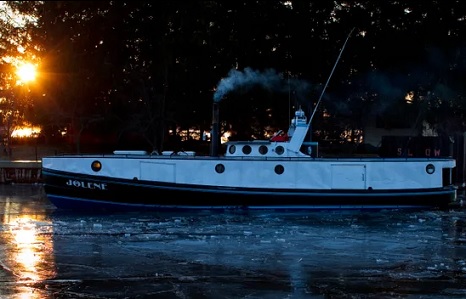
The last in a long line of Milwaukee commercial fishermen sets course for Alaska
The men have always started their day wondering whether a load of fish is straining the nets that they set the day before. Today their compass doesn’t point them toward any nets at all. The boat’s rumbling 855 Cummins diesel pushes them down the muddy Kinnickinnic River and under the Hoan Bridge. This is the moment when their eyes normally train on the open waters ahead. But today, the 52-year-old man notices his dad, Alvin, is glancing back. I think this is probably going to be the last time I see Milwaukee from the water, 77-year-old Alvin Anderson says. Yeah, his son, Dan, replies glumly. Then Milwaukee’s last working commercial fishing tug – the Alicia Rae – glides through the north gap of the Milwaukee Harbor breakwater. And it is gone. 20 photo’s, >click to read< 08:10

Inland Fisheries: A big fight in Lansing over fishing rules on the Great Lakes
Dana Serafin still hauls in 20,000-pound boatloads of whitefish to supply regional restaurants and markets, Native whitefish, the main livelihood for Serafin and other Great Lakes commercial fishermen, have been in decline for years amid changes to the food web, replaced in Serafin’s nets by healthier populations of walleye and lake trout that he’s not allowed to keep. Chinook salmon, once a favorite of recreational anglers on lakes Michigan and Huron, have also plummeted in Lake Michigan, and all but disappeared from Lake Huron. Battles are brewing over fishing rights from recreational, commercial, Native American, and environmental group meddling. Video, >click to read< 13:41

Gloves Come Off In Fight Over Commercial Fishing In Michigan
The few commercial fishing businesses that remain in Michigan are suing the state’s Department of Natural Resources over changes to industry rules. They say the new provisions will make commercial fishing all but impossible. The lawsuit, filed by the Michigan Fish Producers Association, claims the actions of the state threaten to deprive its members and their employees of their livelihoods. “Here in Leland, you can’t fish,” says Joel Petersen, the last state-licensed fishermen working out of Fishtown. >click to read< 09:35

Know Your Fisherman: Henriksen Fisheries
The bountiful waters of Lake Michigan surround Door County, making it home to a vibrant fishing community that dates back to the mid-1800s. That community today includes several larger commercial fishing operations, including Henriksen Fisheries. The fishermen, Charlie and Will Henriksen, along with two year-round and several part-time employees. Henriksen, who’s from the Chicago area, got his first taste of Door County fishing some 40 years ago when he was recruited to help ice fish one winter. He arrived in the county at age 20 to assist his father, who had bought an old hotel in Ellison Bay, and, as the story goes, he never left. >click to read< 11:34

A February fishing adventure
Can you imagine spending 15 hours out on Lake Michigan on a day like today? Me neither. But many commercial fishermen here did just that in the mid-20th century, if they could maneuver through the ice floes. Tucked away in the archives of the Kenosha History Center is a letter written by Kenoshan LeRoy Nohling, dated Feb. 14, 1931. LeRoy, 24, related his experience of that week: “Nathan, my cousin, called up about midnight the night before to suggest that as long as neither of us were working, we might as well take a trip on one of the fishing boats here in the harbor. At six in the morning, we were down at the pier looking ‘em over.,, Off to the fishing grounds! >click to read< 19:32
1937 lake tragedy kills Kenoshans on the Marold II – This is the second part of a two-part series. Sunday’s first installment of this month’s Old Kenosha focused on the commercial fishing trade here in 1931 as told by a young man who joined the crew of the Marold II for a day. >click to read<
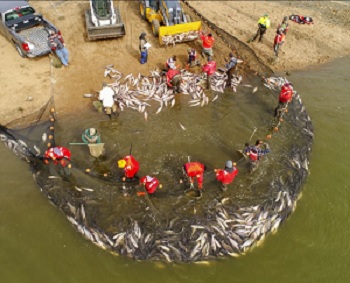
Asian carp: Turning a nuisance into a commodity for the Great Lakes
One of the great myths about Asian carp is that the war against them will be won if the Great Lakes region succeeds in keeping them out of Lake Michigan. Indeed the stakes are high in that part of the Midwest, including in communities that wrap around the fertile fishing waters of Lake Erie’s western basin, and the rivers that feed into the lake.,, But the Great Lakes are the site of only one battle in the Asian carp war, and environmental experts contend there is no apparent end in sight to what has evolved over several decades into a slow-moving biological disaster cutting across the heart of North America, Video, photo’s, >click to read< 17:20

The story of how salmon got to the Great Lakes, told by the man who made it happen
Close to 10 million chinook and coho salmon swim in Lake Michigan, Lake Huron and Lake Superior. There were none when Howard Tanner started as the chief of the Michigan Department of Conservation’s Fish Division in 1964. His boss, Ralph MacMullan, spent much of their first meeting lambasting the fish department for its previous lack of action and dysfunction. Heaps of dead fish were washing up on beaches, the lakes were overly commercially fished and there was little recreational fishing to speak of. He gave Tanner a mandate: “Do something. “And if you can,” he added, “make it spectacular.” By introducing salmon into the Great Lakes in the 1960s, Tanner did just that. >click to read<12:26

Lake Michigan has become dramatically clearer in last 20 years — but at a steep cost
Decades ago, Lake Michigan teemed with nutrients and green algae, casting a brownish-green hue that resembled the mouth of an inland river rather than a vast, open-water lake. Back then, the lake’s swampy complexion was less than inviting to swimmers and kayakers, but it supported a robust fishing industry as several commercial companies trawled for perch, and sport fishermen cast their lines for trout. But in the past 20 years, Lake Michigan has undergone a dramatic transformation. >click here to read< 16:38

Inland Fisheries: DNR proposes a study on the effect of commercial gill nets on Lake Michigan
The Department of Natural Resources has proposed a study of the impacts of commercial gill netting on non-target sport fish such as chinook salmon and brown trout in the Wisconsin waters of Lake Michigan. Commercial fishers in Zone 3 have lobbied the agency for the ability to use large mesh gill nets to catch lake whitefish. The gear has been prohibited in the zone, which covers the Wisconsin waters of Lake Michigan south of Bailey’s Harbor, to prevent bycatch and mortality of sport fish as well as user conflicts. However, large mesh gill nets are allowed for commercial fishing in northern Lake Michigan and part of Green Bay. Commercial fishers have requested the same opportunity in Zone 3. click here to read the story 15:11

Hickeys Launch New Commercial Fishing Vessel
The Gunnar J is the new 46-foot aluminum trap net boat powered by a Cummins QSC 660 engine, built by Hickey Bros. Research. The construction was supervised by Todd Stuth at Hickey Bros. Research, with help from Dennis and Jeff Hickey, Steve Warwick and John Tong. The boat will fish Lake Michigan for the Hickey Bros. Fishery. It is named after Gunnar Stuth, son of Todd Stuth and the youngest grandson of Dennis Hickey. link 08:41

The Fisherman Who Saved Fishtown
Fishtown looks as it did a half-century ago, when it was simply a fishing port. The commercial fishing boats, the Janice Sue and the Joy, bob slightly on gentle wakes left by charter boats heading out of the river. And smoke drifting from the crooked-arm chimneys of a smokehouse beside the white clapboard Carlson’s Fisheries is a sign that the business of fish mongering is well underway. Inside, a second pot of coffee is brewing in the big Bunn coffeemaker, and a hundred pounds of whitefish have just lost their pinbones to the deft hands of four Carlsons: Bill Carlson, owner of the fishery and of Fishtown, his wife Jennifer, his son Clay, and his great nephew, Chris Herman. Clad in suspenderes foul-weather pants, streaked now in blood, the foursome has worked shoulder-to-shoulder for over an hour. They banter as they work—Bill quips that his white hair is really blonde, turned from eating too much fish. Good read, click here to read the story 08:00
Invasive Asian carp less than 50 miles from Lake Michigan
 The news is mixed as Great Lake states and the federal government continue to devote money and brainpower to stopping a potential Great Lakes ecological disaster — invasive Asian carp species making their way from the Mississippi River into Lake Michigan. First the good news: The leading edge of the mass of bighead and silver carp hasn’t made much progress lately up the Mississippi and connected rivers toward Lake Michigan. Now the bad news: The younger fish — juveniles — are moving closer, the evidence shows. And they can do more damage. “The bottom line is that the juvenile front is advancing, and made a big jump last year,” said Joel Brammeier, president and CEO of the nonprofit Alliance for the Great Lakes. “And we still don’t have a permanent solution in place that’s going to solve this problem.” Read the story here 08:59
The news is mixed as Great Lake states and the federal government continue to devote money and brainpower to stopping a potential Great Lakes ecological disaster — invasive Asian carp species making their way from the Mississippi River into Lake Michigan. First the good news: The leading edge of the mass of bighead and silver carp hasn’t made much progress lately up the Mississippi and connected rivers toward Lake Michigan. Now the bad news: The younger fish — juveniles — are moving closer, the evidence shows. And they can do more damage. “The bottom line is that the juvenile front is advancing, and made a big jump last year,” said Joel Brammeier, president and CEO of the nonprofit Alliance for the Great Lakes. “And we still don’t have a permanent solution in place that’s going to solve this problem.” Read the story here 08:59
Wisconsin DNR ponders commercial whitefish regulation changes, Sport fishers concerned
 A leading Wisconsin sportfishing advocate is urging anglers to provide input as the Department of Natural Resources considers changes to rules in Green Bay and Lake Michigan. Based on shifts in whitefish abundance, the DNR is mulling changes to its commercial fishing framework for the species. Although the agency has yet to release a proposed rules change, commercial interests have been seeking higher whitefish quotas in southern Green Bay or the ability to use unfilled quotas from other zones in the lower bay. And some commercial fishers would like to be able to sell walleye taken as “bycatch.” Walleye currently are protected from commercial fishing in Wisconsin. Read the rest here 16:39
A leading Wisconsin sportfishing advocate is urging anglers to provide input as the Department of Natural Resources considers changes to rules in Green Bay and Lake Michigan. Based on shifts in whitefish abundance, the DNR is mulling changes to its commercial fishing framework for the species. Although the agency has yet to release a proposed rules change, commercial interests have been seeking higher whitefish quotas in southern Green Bay or the ability to use unfilled quotas from other zones in the lower bay. And some commercial fishers would like to be able to sell walleye taken as “bycatch.” Walleye currently are protected from commercial fishing in Wisconsin. Read the rest here 16:39
A dream becomes a nightmare
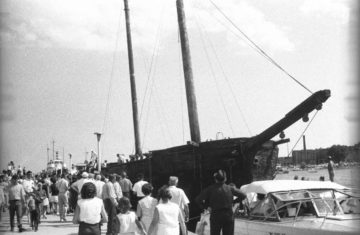 When Dick Garbowski, a commercial fisherman in Green Bay, snagged an expensive net on an unknown obstruction in Lake Michigan in 1967, he probably did not know that he would set events in motion that would culminate in crushed dreams and a demolished schooner with a historical designation. Garbowski called an experienced diver and friend, Frank Hoffman, to help him free his $1,400 fishing net. The two originally kept their problem a secret, because as V.O. Van Heest writes in “Lost and Found,” “Garbowski had kept quiet about the predicament worried that someone might hear about it and try to abscond with the $1,400 net. Hoffman, too, had kept quiet because he knew that news of a new wreck could bring out other divers intent on looting.” was not until the summer of 1968 that the net was finally freed and Frank Hoffman realized he had an almost intact shipwreck to explore. The shipwreck was the Alvin Clark. Read the story here 16:42
When Dick Garbowski, a commercial fisherman in Green Bay, snagged an expensive net on an unknown obstruction in Lake Michigan in 1967, he probably did not know that he would set events in motion that would culminate in crushed dreams and a demolished schooner with a historical designation. Garbowski called an experienced diver and friend, Frank Hoffman, to help him free his $1,400 fishing net. The two originally kept their problem a secret, because as V.O. Van Heest writes in “Lost and Found,” “Garbowski had kept quiet about the predicament worried that someone might hear about it and try to abscond with the $1,400 net. Hoffman, too, had kept quiet because he knew that news of a new wreck could bring out other divers intent on looting.” was not until the summer of 1968 that the net was finally freed and Frank Hoffman realized he had an almost intact shipwreck to explore. The shipwreck was the Alvin Clark. Read the story here 16:42
Michigan Considers Controversial Commercial Net-Pen Aquaculture in Huron and Michigan
 Several State agencies are looking at proposals to allow commercial net-pen aquaculture on the Great Lakes. The practice is controversial because of environmental concerns. WDET’s Amy Miller spoke with Tammy Newcomb; Senior Policy Advisor for the Department of Natural Resources. She says Ontario has allowed a few net-pens near Georgian Bay and now there are two Michigan proposals. This week the State is holding two public hearings on the two Great Lakes net-pen aquaculture proposals. Listen to the report here 08:29
Several State agencies are looking at proposals to allow commercial net-pen aquaculture on the Great Lakes. The practice is controversial because of environmental concerns. WDET’s Amy Miller spoke with Tammy Newcomb; Senior Policy Advisor for the Department of Natural Resources. She says Ontario has allowed a few net-pens near Georgian Bay and now there are two Michigan proposals. This week the State is holding two public hearings on the two Great Lakes net-pen aquaculture proposals. Listen to the report here 08:29
Smeltdown: Small fish continues Great Lakes vanishing act

Like so many fish people associate with the Great Lakes, the rainbow smelt is an invasive species. The approximately 6-inch fish is native to the Atlantic and Pacific oceans, but moves into freshwater to spawn. It was first stocked in Crystal Lake in Benzie County in 1912, after several unsuccessful attempts to stock smelt in the St. Mary’s River to support another transplanted fish, Atlantic salmon. Smelt were found in Lake Michigan in 1923 and then spread throughout the Great Lakes. The commercial harvest of smelt on the Great Lakes reached 4.8 million pounds by 1941. Read the rest here 10:03
Whitefish population healthy in Green Bay, Lake Michigan
 Winter weather and state regulations, not a dropping whitefish population, led to some shortages of the popular species this spring. “It’s not a stock problem,” said Wisconsin Commercial Fisheries Association president Charlie Henriksen of Sister Bay, a commercial fishermen who sets nets in both Green Bay and Lake Michigan. “It’s a Mother Nature problem.” doorcountyadvocate.com Read more here 15:54
Winter weather and state regulations, not a dropping whitefish population, led to some shortages of the popular species this spring. “It’s not a stock problem,” said Wisconsin Commercial Fisheries Association president Charlie Henriksen of Sister Bay, a commercial fishermen who sets nets in both Green Bay and Lake Michigan. “It’s a Mother Nature problem.” doorcountyadvocate.com Read more here 15:54
Possibly due to improving water quality a century later, Lake Michigan whitefish are turning up in Wisconsin rivers
 Marinette — The venerable Lake Michigan whitefish — a favorite of ice anglers and commercial fishermen — is turning up on inland waters where it hasn’t been seen in a century. Adult fish populations are leaving Green Bay and have been found in at least four rivers in northeast Wisconsin, possibly due to improving water quality of those rivers, says the Wisconsin Department of Natural Resources. more@jsonline 20:23
Marinette — The venerable Lake Michigan whitefish — a favorite of ice anglers and commercial fishermen — is turning up on inland waters where it hasn’t been seen in a century. Adult fish populations are leaving Green Bay and have been found in at least four rivers in northeast Wisconsin, possibly due to improving water quality of those rivers, says the Wisconsin Department of Natural Resources. more@jsonline 20:23
Little River Band of Ottawa Indians takes steps toward retrieving some fishing nets from Lake Michigan
 Although commercial fisherman Thomas Battice has been sent to prison, his trap nets in Lake Michigan can’t just be pulled out by anyone who wants them out. The Little River Band of Ottawa Indians, which licensed Battice, did what it could to start the process for removing Battice’s nets this week, though, and said in a press release Friday that the nets would eventually be retrieved. more@ludingtondailynews
Although commercial fisherman Thomas Battice has been sent to prison, his trap nets in Lake Michigan can’t just be pulled out by anyone who wants them out. The Little River Band of Ottawa Indians, which licensed Battice, did what it could to start the process for removing Battice’s nets this week, though, and said in a press release Friday that the nets would eventually be retrieved. more@ludingtondailynews
Thomas Battice sentenced to prison – the story
Saugatuck charter boat captain seeks jury trial on 8 charges
Undercover operation lead to charges of fishing without license, no inspection certificate for Gregg John Mariuz. The charges are five counts of fishing without a license, each of which has a fine of $225; advertising a charter boat for passengers without a certificate, which has a penalty of up to one year in jail and/or a $1,000 fine; commercial fishing without a license, which has a penalty of 60 days in jail and/or a fine of $25 to $100; no certificate of inspection/non-licensed pilot of a charter boat, a penalty of a year in jail and/or a $1,000 fine and possible forfeiture of the vessel. more@hollindsentinal
Commercial fishing is Petersen legacy as fourth generation continues a Muskegon tradition
 MUSKEGON, MI – For a fourth generation Lake Michigan commercial fisherman trying to establish a fresh-fish retail and wholesale business in Muskegon, the 18-hour days are brutal. continued@mlive
MUSKEGON, MI – For a fourth generation Lake Michigan commercial fisherman trying to establish a fresh-fish retail and wholesale business in Muskegon, the 18-hour days are brutal. continued@mlive
New England offshore wind planning offers lessons for Great Lakes
When Scandia, a Norwegian wind company, announced its plans to install 200 turbines in Lake Michigan four miles from the tourist town of Ludington, Michigan, in 2009, they likely didn’t anticipate the controversy that would erupt. A similar brouhaha unfolded over the past decade in Nantucket Sound, off the southern coast of Cape Cod, over a proposed 468 MW wind farm known as Cape Wind. Residents of the area spent nine years fighting the project before the Interior Department approved it in 2010. Conservationists have their own set of what-ifs, as do commercial fishers. A systematic mapping approach could help them meet their goals as well, said Sally McGee, who directs the Northeast Marine Program for the Nature Conservancy and serves on the New England Fishery Management Council, the major regional planning body for the fishing industry. Read more here


































